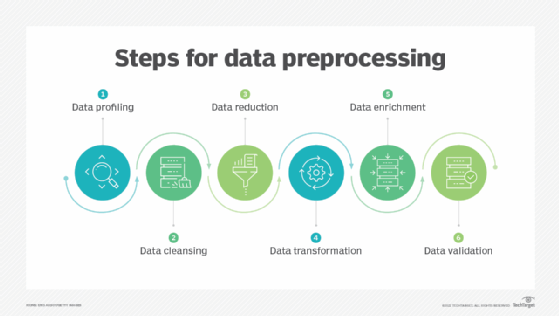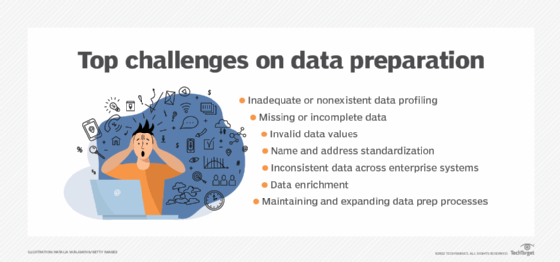What is data preprocessing? Key steps and techniques (original) (raw)
By
Published: Mar 12, 2025
Data preprocessing, a component of data preparation, describes any type of processing performed on raw data to prepare it for another data processing procedure. It has traditionally been an important preliminary step for data mining. More recently, data preprocessing techniques have been adapted for training machine learning (ML) models and artificial intelligence (AI) models and for running inferences against them.
Data preprocessing transforms data into a format that's more easily and effectively processed in data mining, and other data science tasks. The techniques are generally used at the earliest stages of the ML and AI development pipeline to ensure accurate results.
Several tools and methods are used to preprocess data:
- Sampling. This approach selects a representative subset from a large population of data.
- Transformation. This is a way to manipulate raw data to produce a single input.
- Denoising. This removes noise from data.
- Imputation. This method synthesizes statistically relevant data for missing values.
- Normalization. A way of organizing data for more efficient access.
- Feature extraction. This approach pulls out a relevant feature subset that's significant in a particular context.
These tools and methods can be used on a variety of data sources, including data stored in files and databases and streaming data.
Why is data preprocessing important?
Virtually any type of data analysis, data science or AI development requires some type of data preprocessing to provide reliable, precise and significant results for enterprise applications.
Real-world data is messy and often created, processed and stored by various people, business processes and applications. As a result, a data set might be missing individual fields, contain manual input errors and have duplicate data or different names to describe the same thing. People often identify and rectify these problems as they use the data in business dealings. However, data used to train ML or deep learning algorithms must be automatically preprocessed.
Deep learning and machine learning algorithms work best when data is presented in a format that highlights the relevant aspects required to solve a problem. Feature engineering practices that involve data wrangling, data transformation, data reduction, feature selection and feature scaling help restructure raw data into a form suited for particular types of algorithms. This can reduce the processing power and time required to train a new ML or AI algorithm or run an inference against it.
One challenge in preprocessing data is the potential for re-encoding bias into the data set. Identifying and correcting bias is critical for applications that help make decisions that affect people, such as loan approvals. Although data scientists might deliberately ignore variables, such as gender, race and religion, these traits can be correlated with other variables, such as zip codes or schools attended, generating biased results.
Most modern data science packages and services include preprocessing libraries that help automate many of these tasks.
There are six steps in the data preprocessing process:
- Data profiling. This is the process of examining, analyzing and reviewing data to collect statistics about its quality. Data profiling starts with a survey of existing data and its characteristics. Data scientists identify data sets pertinent to the problem at hand, inventory their attributes and form a hypothesis about the features that might be relevant to the proposed analytics or ML task. They also relate data sources to the relevant business concepts and consider which preprocessing libraries could be used.
- Data cleansing. The aim here is to find the easiest way to rectify quality issues, such as eliminating bad data, filling in missing data and otherwise ensuring the raw data is suitable for feature engineering.
- Data reduction. Raw data sets often include redundant data that comes from characterizing phenomena in different ways or data that isn't relevant to a particular ML, AI or analytics task. Data reduction techniques, such as principal component analysis, transform raw data into a simpler form suitable for specific use cases.
- Data transformation. Here, data scientists think about how different aspects of the data need to be organized to make the most sense for the goal. This could include things such as structuring unstructured data, aggregation, combining salient variables when it makes sense or identifying important ranges to focus on.
- Data enrichment. In this step, data scientists apply various feature engineering libraries to the data to get desired transformations. The result should be a data set organized to achieve the optimal balance between the model training time and the required compute.
- Data validation. At this stage, the data is split into two sets. The first set is used to train an ML or deep learning model. The second set is the testing data that's used to gauge the accuracy and feature set of the resulting model. These test sets help identify any problems in the hypothesis used in the data cleaning and feature engineering. If the data scientists are satisfied with the results, they can push the preprocessing task to a data engineer who figures out how to scale it for production. If not, the data scientists go back and change how they executed the data cleansing and feature engineering steps.

Data preprocessing typically includes six key steps.
Applications for data preprocessing
Some common applications of data preprocessing include the following:
- AI and ML models. Data preprocessing plays a key role in early stages of ML and AI application development. In an AI context, data preprocessing is used to improve the way data is cleansed, transformed and structured to enhance the accuracy of a model while reducing the amount of compute required.
- Customer satisfaction. A good data preprocessing pipeline creates reusable components that make it easier to test various ideas for streamlining business processes or improving customer satisfaction. For example, preprocessing can adjust the age ranges used to categorize customers, improving how data is organized for a recommendation engine.
- Business intelligence insights. Preprocessing can simplify the work of creating and modifying data for more accurate and targeted BI insights. For example, customers of different categories or regions might exhibit different behaviors across regions. Preprocessing the data into the appropriate forms could help BI teams weave these insights into BI dashboards.
- Customer relationship management. With CRM, data preprocessing is a component of web mining that uses data mining techniques to extract information from web data. Web use logs can be preprocessed to extract meaningful data sets called user transactions, which consist of groups of URL references. User sessions can be tracked to identify the user, the websites requested, their order and the time spent on each one. Once these have been pulled out of the raw data, they yield useful information that can be applied to consumer research, marketing and personalization.
- Healthcare. Preprocessing techniques, such as noise reduction and normalization, enhance image quality and improve diagnostic accuracy in medical image analysis. Noise reduction removes unwanted artifacts, making subtle details in medical images clearer. Normalization standardizes pixel intensities, ensuring consistent image representation across different scans.
- Outliers. Data preprocessing often handles outliers, which are data points that deviate from the dominant pattern in the data set. Outliers often skew statistical analyses and negatively affect machine learning model performance. Preprocessing techniques involve removing, transforming or replacing outliers with more representative values.
- Autonomous vehicles. Data preprocessing is crucial for autonomous cars as it cleans and enhances raw sensor data from cameras, lidar and radar. It removes noise, corrects distortions and integrates data into a clear environmental model, improving computer vision algorithms.
Data preprocessing techniques
There are two main categories of preprocessing: data cleansing and feature engineering. Each includes a variety of techniques, as detailed below.
Data cleansing
Techniques for cleaning messy data include the following:
- Identify and sort out missing data. There are various reasons a data set might be missing individual data fields. Data scientists must decide whether it's better to discard records with missing fields, ignore them or fill them in with a probable value. For example, in an internet of things application that records temperature, adding in a missing average temperature between the previous and subsequent record might be a safe fix.
- Reduce noisy data. Real-world data is often noisy because of errors in data collection that can distort an analytic or AI model. For example, a temperature sensor that consistently reports a temperature of 75 degrees Fahrenheit might erroneously report a temperature as 250 degrees. Various statistical approaches can be used to reduce noisy data, including binning, regression and clustering.
- Identify and remove duplicate records. When two records seem to repeat, an algorithm needs to determine if the same measurement was recorded twice or if the records represent different events. In some cases, there may be slight differences in a record because one field was recorded incorrectly. In other cases, records that seem to be duplicates might indeed be different, such as when a father and son with the same name are living in the same house but should be represented as separate individuals. Techniques for identifying and removing or joining duplicates can help to address these problems.
Feature engineering
Data scientists use feature engineering techniques to organize the data in ways that make it more efficient to train data models and run inferences against them. These techniques include the following:
- Feature scaling or normalization. Often, multiple variables change over different scales, or one changes linearly while another exponentially. For example, salary might be measured in thousands of dollars, while age is represented in double digits. Scaling data helps to transform it in a way that makes it easier for algorithms to tease apart a meaningful relationship between variables.
- Data reduction. Data scientists often need to combine various data sources to create a new AI or analytics model. Some variables might not correlate with a given outcome and can be safely discarded. Other variables might be relevant, but only in terms of a relationship where they can be combined into a single variable. This is the case with the ratio of debt to credit in a model predicting the likelihood of a loan repayment. Techniques such as principal component analysis play a key role in reducing the number of dimensions in a training data set into a more efficient representation.
- Discretization. It's often useful to lump raw numbers into discrete intervals. For example, income might be broken into five ranges that represent people who typically apply for a given type of loan. This can reduce the overhead required to train a model or run inferences against it.
- Feature encoding. Another aspect of feature engineering involves organizing unstructured data into a structured format. Unstructured data formats usually include text, audio and video. For example, the process of developing natural language processing algorithms typically starts with using data transformation algorithms such as Word2vec to translate words into numerical vectors. This makes it easy to represent to the algorithm that words like mail and parcel are similar, while a word like house is completely different. Similarly, a facial recognition algorithm might re-encode raw pixel data into vectors representing the distances between parts of the face.
Advantages and disadvantages of data preprocessing
Data preprocessing is critical in transforming raw data into a clean and structured format for easy modeling. Some common benefits of data preprocessing include the following:
- Improved data quality. Data preprocessing enhances data quality by eliminating noise and inconsistencies, leading to refined data sets and high-quality, reliable models.
- Efficient resource use. Data preprocessing minimizes computational requirements by reducing noise and dimensionality, leading to faster processing times and better resource consumption.
- Enhanced model performance. Organizing data into appropriate formats and structures enables the creation of new features and enhances model performance and training. For instance, AI models learn to effectively use the insights gained from training data and apply that knowledge to new, previously unseen data.
- Easier data integration. Integrating data from different sources through preprocessing creates a cohesive view. This reveals relationships and patterns that would otherwise be hidden in fragmented data, and it enables deeper analysis and more informed decision-making.
Data preprocessing also provides some challenges, including the following:
- Time-consuming. Cleaning and preparing data for analysis is a labor-intensive process that takes time. It requires careful handling of missing values, outliers and formatting errors, necessitating manual inspection.
- Complexities in handling diverse data. Handling varied data types from multiple sources complicates preprocessing workflows and requires specialized techniques and tools to ensure accuracy.
- Potential for data loss. Aggressive data cleaning and transformation aimed at achieving highly standardized results can unintentionally remove valuable information. This can negatively affect the quality of derived insights. Also, poor feature selection leads to models that either overfit or underfit the training data, missing essential patterns in a data set.
- Data management issues. Data sets are constantly evolving and require regular updates to prevent inconsistencies. However, this often complicates data management and tracking of data preprocessing, especially when there is insufficient documentation.

Various issues complicate the process of preparing data for business intelligence and analytics applications.
Common data preprocessing tools
According to TechTarget's research, some examples of commonly used data preprocessing tools include the following:
- NumPy. NumPy is a powerful Python library that provides an efficient, array-based computing environment optimized for managing numerical data and helping to preprocess data. Its speed and versatility make it an important tool for scientific computing, data analysis and ML tasks.
- OpenRefine. This tool is designed for working with messy data. It cleans, transforms and reconciles data sets to improve consistency and quality.
- Pandas. This open source Python library is used for data analysis, cleaning and making data visualization easier. Its features include handling missing data, as well as filtering, transforming and aggregating large data sets.
- Scikit-learn. This is an open source ML library for Python. It provides a suite of tools for data preprocessing, including scaling, normalization, encoding categorical variables and feature selection.
Data profiling involves analyzing and evaluating the quality, structure and consistency of a data set. Explore the top data profiling tools and learn what criteria to use to select the best tool for your organization's needs.
Continue Reading About What is data preprocessing? Key steps and techniques
- Top data preparation challenges and how to overcome them
- Self-service data preparation: What it is and how it helps users
- The future of business intelligence: Top trends
- Data lake governance: Benefits, challenges and getting started
- How to build a data protection policy, with template
 What is computer-aided diagnosis?
What is computer-aided diagnosis?  By: Stephen Bigelow
By: Stephen Bigelow  What is a data lake?
What is a data lake?  By: Nick Barney
By: Nick Barney  Data preparation in machine learning: 4 key steps
Data preparation in machine learning: 4 key steps  By: Donald Farmer
By: Donald Farmer  AI engineer vs. data scientist: What's the difference?
AI engineer vs. data scientist: What's the difference?  By: Lev Craig
By: Lev Craig